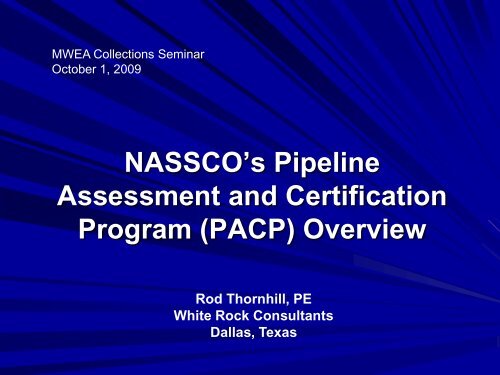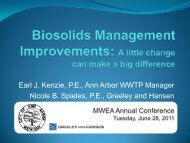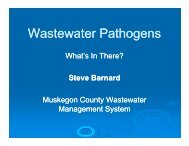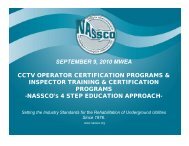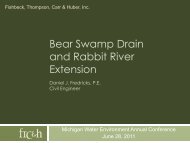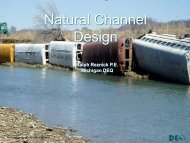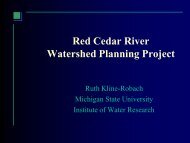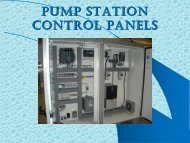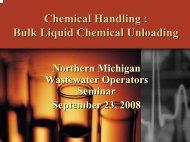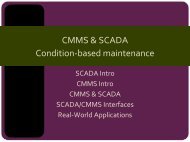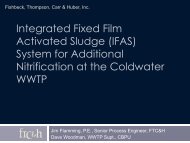NASSCO's Pipeline Assessment and Certification Program (PACP)
NASSCO's Pipeline Assessment and Certification Program (PACP)
NASSCO's Pipeline Assessment and Certification Program (PACP)
You also want an ePaper? Increase the reach of your titles
YUMPU automatically turns print PDFs into web optimized ePapers that Google loves.
Introduction to NASSCOFounded in 1976, NASSCO is the NationalAssociation of Sewer Service Companies.Our mission is to set industry st<strong>and</strong>ards forthe rehabilitation of underground pipelines<strong>and</strong> to assure the continued acceptance <strong>and</strong>growth of trenchless technologies.NASSCO is an impartial organization serving allfacets of the sewer service industry.
NASSCO’s 4-Step IndustryEducation Approach
Step 1:Underst<strong>and</strong>ing Deterioration MechanismsEducate the Industry on how to identify problems intheir sewer infrastructure system with a commondefect identification program – <strong>PACP</strong>, MACP, LACP.Define sewer pipeline deterioration modes that arecommon to systems containing similar materials butin different locations <strong>and</strong> climate conditions.Assist Engineers <strong>and</strong> Municipalties on settingrenewal priorites based on the documentedcondition of the sewer system.
Step 2:Underst<strong>and</strong>ing Available TechnologiesContinually educating the industry on the existing <strong>and</strong>developing technolgies that can be used to renew the sewerinfrastructureProvide the tools for selecting the correct renewal technologyfor the sewer pipeline documented conditionsWorking with the Trenchless Technology Center (TTC) ofLouisiana Tech University to develop a computerizedTrenchless <strong>Assessment</strong> Guide for Rehabilitation (TAG-R). Thisguide will give the industry the tool to quickly <strong>and</strong> effectivelydetermine correct technology applications based on theexisting condition of the pipeline
Step 3:Underst<strong>and</strong>ing SpecificationsWrite st<strong>and</strong>ard performance-based specificationsthat are made available to the IndustryInclude quality assurance <strong>and</strong> quality controlst<strong>and</strong>ards that promote quality productinstallation/application/constructionProvide st<strong>and</strong>ards for testing of the installedproducts to verify that the customer receives theproduct purchased
Step 4:Inspector TrainingCertify <strong>and</strong> train project engineers <strong>and</strong> fieldinspectors to better underst<strong>and</strong> each technology <strong>and</strong>how the technology is constructed in the fieldUnderst<strong>and</strong>ing key elements of the contractspecifications to ensure successful installationsDefine quality assurance requirementsProvide st<strong>and</strong>ard checklists <strong>and</strong> forms for accuratefield documentation
We Need to Avoid SewerProblems Finding Us!
Miles of PipeHistory of Sewer Pipe Installation1400001200001000008000060000400002000001880 1900 1920 1940 1960 1980EPA Gap Analysis
Age in YearsAverage Age of Sewer Pipes10090807060504030201001910 1930 1950 1970 1990 2010 2030 2050EPA Gap Analysis
Estimated Conditionof Sewer Pipes In 1980FailurePoor/Very PoorFairGoodExcellent55369 19EPA Gap Analysis
Estimated Conditionof Sewer Pipes In 2020FailurePoor/Very PoorFairGoodExcellent933331112EPA Gap Analysis
PercentEstimated Change in Pipe Condition1009080706050403020100FailedPoor/VeryPoorFair Good Excellent198020002020EPA Gap Analysis
Summary OfTV Inspection HistoryOnly been around about 45 yearsMade possible the creation of the trenchlesstechnology industryMost sewers today were only televised yearsafter constructionLarge amount of existing TV dataNeed effective way to manage volume of data
Industry Parallels• St<strong>and</strong>ard Methods for the Examination of Water<strong>and</strong> Wastewater (St<strong>and</strong>ard Methods)st<strong>and</strong>ardmethods.org• Joint Publication of APHA, AWWA, WEF• Began in 1905, now in 20 th , Edition, 350separate measurements
Proactive Renovation<strong>and</strong> Replacement using APWA PaverprogramThe pavementManagementindustry has usedconditionassessment tojustify costeffectiveproactiverenovation
Origin of Water ResearchCentre (WRc)Condition CodesUK codes initially developed late 70s, early80s.Adaptations for use in Australia, Canada, <strong>and</strong>elsewhere.Prior to NASSCO codes US industry had nosingle st<strong>and</strong>ard coding system.WRc codes were modified <strong>and</strong> widely used inNorth America, however no st<strong>and</strong>ard versionwas ever established
Origin of WRcCondition Codes (Cont’d)Applied to help correlate sewer condition <strong>and</strong>sewer rate charges after privatization ofindustry in the UK.NASSCO obtained assistance from WRc in2001 <strong>and</strong> first <strong>PACP</strong> class held in Jan 2002St<strong>and</strong>ardization concept more importantthan the benefits of one code systemcompared to another.
Reasons for CCTV SurveyRoutine Operational Requirements –Proactive inspection to identify potentialfailures <strong>and</strong> for planning routine O&M <strong>and</strong>renovation programs.Troubleshooting – Investigation of problemincidents to select remedial actionCompliance with M<strong>and</strong>ated <strong>Program</strong>s –Inspection <strong>and</strong> data collection to supportprograms such as C-MOM <strong>and</strong> GASB-34.
Reasons for CCTV Survey(Cont’d)• Acceptance Testing – Inspection of new orrenewed sewers to insure that constructionmet specifications <strong>and</strong> to document as-builtconditions.• I/I or CIP Projects – Examples of the typeprojects normally conducted by specialty firmsor engineering consultants.The <strong>PACP</strong> emphasized that all TV Inspections should beconducted thoroughly <strong>and</strong> consistently regardless of thereason for TV
Desired Results ofa CCTV SurveyRecord <strong>and</strong> Archive All Descriptive DataDevelop a Condition Rating for Each LineProvide Follow-up RecommendationsDisplay Results on a MapEstablish Benchmarks To Compare With FutureInspections Of Same LineEstimate Probability of Failure <strong>and</strong> LifeExpectancy
Why St<strong>and</strong>ardization ofCodes is ImportantAllows for more effort to be placed onconsistency of data <strong>and</strong> utilization of data ratherthan development of utility-specific or projectspecificst<strong>and</strong>ardsProvides the capability of benchmarking sewerswithin a single utility as well as from onegeographical area of the US to anotherProvides the ability to detect change due todeterioration over time
Why St<strong>and</strong>ardizationof Codes Important (Cont’d)Provides better opportunities for integrating data fromdifferent software programsImproves confidence in the description of pipe conditionsthat will provide cost savings during renewalCreates many opportunities for continual improvementby consistently describing conditions in a st<strong>and</strong>ard wayover timeAdvances the professionalism of TV Inspection industry
Summary of NASSCO<strong>Pipeline</strong> <strong>Assessment</strong> <strong>and</strong> <strong>Certification</strong><strong>Program</strong> (<strong>PACP</strong>)Modification/Adoption of st<strong>and</strong>ard codes <strong>and</strong> ratingsTraining <strong>and</strong> certification of operatorsSt<strong>and</strong>ard NASSCO data format<strong>Certification</strong> of software vendorsDefect Grading <strong>and</strong> Severity Ratings for pipelinesProtocol for Quality Control of <strong>PACP</strong> dataNow includes manhole assessments (MACP) <strong>and</strong>soon lateral assessments (LACP)
Modification/Adoption ofst<strong>and</strong>ard codes <strong>and</strong> ratingsAdapt UK codes to the United States marketRe-enforce maintenance related defect codesAdd codes for corrosion evaluation/assessmentDevelop codes specific to rehabilitated sewers
Training <strong>and</strong> <strong>Certification</strong> of UsersUnderst<strong>and</strong>ing of codes <strong>and</strong> interpretation ofdefectsUse of codes in forms <strong>and</strong> softwareTwo day course with certification examIncludes review of pipeline deteriorationmechanisms.Approximately 9,000 Users trained <strong>and</strong>adopted by several hundred utilities
<strong>PACP</strong> Training Explains use ofPipe has acombination oflongitudinal <strong>and</strong>circumferentialcracksCodingDistance(feet)Code Value CircumferentialContinuousVideoJoint locationdefectRef Group / Modifier /S/M/ Inches %At / ToDescrip severityL 1st 2ndfrom80.3 FM J 08 05
Hydrogen Sulfide AttackSTAGE 1Inverted Syphon / Force MainUnder anaerobic (septic) conditions, sulfate present in the wastewater isconverted to sulfides within the slime layer inside the pipe. Force mainsgenerally flow full with little aeration therefore likely points for sulfideproduction. Dissolved oxygen levels must be near zero in order for sulfideproduction to occur.STAGE 2Discharge manhole/gravity sewerSulfides in the wastewater are released by turbulent conditions at dischargepoint into the sewer atmosphere <strong>and</strong> form hydrogen sulfide gas (H2S).TheH2S condenses on the pipe surfaces <strong>and</strong> is converted by bacteria into a weaksulfuric acid. The sulfuric acid attacks concrete <strong>and</strong> metal surfaces.STAGE 1Gravity sewerUnder anaerobic (septic) conditions sulfate present in the wastewater isconverted into sulfides within the slime layer. Sewers with laminar flowtherefore little aeration are most susceptible to low dissolved oxygenlevelsSTAGE 2Turbulence releases dissolved sulfides into the sewer atmosphere in theform of hydrogen sulfide (H2S). The H2S then condenses on sewersurfaces in the form of sulfuric acid. The sulfuric acid attacks cementbased materials <strong>and</strong> metals.
<strong>PACP</strong> ConcretePipe/H2S Damage DescriptorsRoughness increased (SRI)Aggregate visible (SAV)Aggregate projecting (SAP)Aggregate missing (SAM)Reinforcement Visible (SRV)Reinforcement Projecting (SRP)Reinforcement Corroded (SRC)Missing Wall (SMW)
Roots - Medium (RM)Used when the roots are50% or less of thecross-sectional areaDistance(feet)Code Value CircumferentialContinuousVideoJoint locationdefectRef Group / Modifier /S/M/ Inches %At / ToDescrip severityL 1st 2ndfrom251.6 RM S 01 20 J 07 05
<strong>Certification</strong> of Software VendorsAll data fields conform to NASSCOst<strong>and</strong>ardsSoftware has the ability to export <strong>and</strong>import seamlessly to NASSCO st<strong>and</strong>arddata formatData exported from one certified softwareis identical to software from another<strong>PACP</strong> St<strong>and</strong>ard database template freelyavailable to anyone
<strong>PACP</strong> Data St<strong>and</strong>ardsData dictionary defines:– Field names– Field character number <strong>and</strong> format– Valid field data entriesSt<strong>and</strong>ard Database Format (ACCESS)Provide the ability to seamlesslycombine data from various projects
<strong>PACP</strong> QA/QC ProtocolImplementation ImportantProcess for confirming the accuracy of<strong>PACP</strong> codingEfficient collection of <strong>PACP</strong> data requiresaccurate coding (only code once)<strong>PACP</strong> inspections are selected r<strong>and</strong>omlyfor checking by ExpertScore is based on percentage of correctentries divided by total possible entries
<strong>PACP</strong> QA/QC Protocol (Cont’d)Protocol will find gross errors ormisinterpretations by technicians veryearly in the <strong>PACP</strong> coding processCan be used by utilities, contractors, orengineersRelatively small sample set can control alarge number of inspections by usingr<strong>and</strong>om selection of inspections once
Examples of common errors can beused to improve coding qualityVC pipe materialAlthough the Missing Wall code (SMW) <strong>and</strong> the Hole code (H)describe similar defects, missing wall is used where the concrete iscompletely deteriorated, with no pipe material left.
Keys to Re-EngineeringTV Data ManagementPick a st<strong>and</strong>ard, preferably a nationally acceptedst<strong>and</strong>ardUnderst<strong>and</strong> TV Data Management is a program,<strong>and</strong> commit to itProcess all data from all sources consistentlyThink long term, big picture
<strong>PACP</strong> Essential Tool forEstimating Remaining Life• Records in detail the current condition of pipe• Identifies deterioration factors inside the pipe that affectrate of deterioration• Benchmarking of old <strong>and</strong> new inspections is used toground truth rates of deterioration• Long term use of st<strong>and</strong>ard codes provides continualimprovement• <strong>PACP</strong>-based Life Expectancy estimates will constantlybe “corrected” using updated TV inspection conditiondata.
Utilities need to EstablishLevel of Service ObjectivesTraditional Levels of Service are– Occurrence of overflows– Frequency of maintenance callsEmerging Levels of Service are;– Current condition of pipeline– Life expectancy of pipe– Probability of Failure
Don’t Ignore RetrofittingExisting DataVery inexpensive compared to obtaining newdataAudio <strong>and</strong> Video often of excellent qualityCan add up quickly to a considerable portion ofthe systemProvides immediate ability to assess rate ofdeterioration by comparing “old” data to “new”
SummarySt<strong>and</strong>ardization will increase confidence in data <strong>and</strong>the use of the dataDevelop condition ratings <strong>and</strong> recommended followupfor every line televisedMake mapping of results an integral part of theprocessDon’t ignore value of the existing TV dataSt<strong>and</strong>ardized pipe condition data will be an essentialtool for short term <strong>and</strong> longer sewer collectionsystem management


